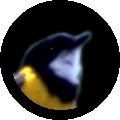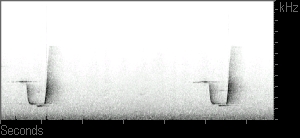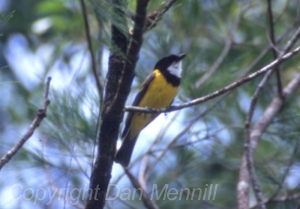 Golden
Whistler
Golden
Whistler Pachycephala pectoralis
 Figure 1. Spectrogram of the
Golden Whistler song.
Figure 1. Spectrogram of the
Golden Whistler song. (The first two songs from the sound file are depicted.)

Golden Whistler - Pachycephala pectoralis
Named for the male’s bright plumage colour and strong voice, golden whistlers are some of the most conspicuous birds in the Atherton rainforests, both visually and acoustically. Each male golden whistler has a repertoire of song types, most of which end with a loud upslurred syllable. Males sing with eventual variety; they repeat one song type a number of times and then switch to a different song type.
The first nine songs in the above sound file come from a continuous recording from a single male. His first three songs are the same song type (the type pictured in figure 1), however his fourth song represents a second song type. The fifth through eighth songs are repeats of his first song type, but on the ninth song he returns to his second song type. The last two songs in the recording come from different males and represent two further song types, the last of which sounds remarkably like the male song of the eastern whipbird.
Neighbouring golden whistlers engage in obvious countersinging behaviour. Males will perch in highly visible locations and countersing back and forth for extended periods. On several occasions I observed two males countersinging with the same song type. This song-type matching is a common feature in birds with repertoires, and is thought to be a signal of directed aggression.
R. J. and M. N. Brown published an intriguing report of duet singing by a pair of golden whistlers in southwest Australia in 1994. They describe a male and female jointly attacking their reflections in the window of the Brown’s home. During the attack, both the male and the female sang songs which appeared to be identical. Furthermore, the male and female appeared to coordinate their songs in the form of an overlapping duet.
Habitat.
Golden whistlers are found in all types of habitat from gardens and golf courses to mangroves and rainforests.
Range.
Four races of golden whistlers are found throughout most of eastern and southern Australia. These recordings are from the P. p. pectoralis race at the extreme northern end of the golden whistler’s distribution.
Further Reading.
M. C. Baker. 1993. Evidence of intraspecific vocal imitation in singing honeyeaters and golden whistlers. Condor. 95:1044-1048.
R. J. Brown & M. N. Brown.
1994. Matched
song and duetting by a breeding pair of golden whistlers Pachycephala
pectoralis.
Emu. 94: 58-59.
No recordings, photographs, or other information may be used without written permission (email me at dmennill AT uwindsor DOT ca).